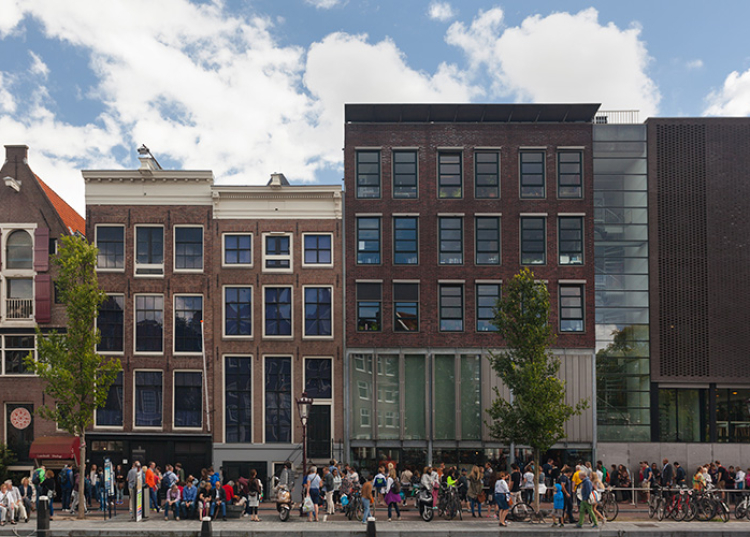Known as the Venice of the North because of its glittering channels that criss-cross the city, Amsterdam has an old history that is represented through its range of historical sites. Originally a small fishing village in the late 12th century, Amsterdam quickly became an important trading centre during the Dutch Golden Age of the 17th century, with stock exchanges and joint ventures giving birth to modern day Capitalism.
Today, the medieval old town is a UNESCO World Heritage Site, and there are a plethora of historic attractions to visit. One of the most well-known is the Anne Frank House, where Anne Frank and her family hid in the secret annexe during the Second World War. Here’s our pick of some sites in Amsterdam which make for essential visiting, plus a handful located outside the capital that are great when taking a day trip from the capital.

1. The Royal Palace - Amsterdam
The Royal Palace in Amsterdam was designed by architect Jacob van Campen in 1648 with the intention that it serve as Amsterdam’s city hall, which it did for 150 years or so. During this time, it was the largest secular building in Europe, though it was not to remain so.
Today, The Royal Palace in Amsterdam is one of three palaces at the disposal of the monarch of the Netherlands, Queen Beatrix. When open to the public, the Royal Palace provides guided tours of its ornately decorated interiors, including the expansive Citizens’ Hall and the palace’s many sculptures and paintings. When available there is a free audio tour.

2. Anne Frank’s House
Anne Frank’s house was the site where German Jewish teenager and Holocaust victim Anne Frank, her family, the van Pels family and later a man called Fritz Pfeffer went into hiding from the Nazis during the Second World War.
Anne Frank’s House is now a museum allowing visitors to see the moving bookcase, walk through the cramped secret annex and gain a true appreciation of the hardship this group endured in their fight for survival. The Anne Frank Museum has collected and exhibits many original letters, photos and objects belonging to the Frank family as well as to the van Pels and Fritz Pfeffer. Anne Frank’s original diary is also on display.

3. Rembrandt House
Rembrandt House was the home of the Dutch painter Rembrandt Harmenszoon van Rijn between 1639 and 1658. The house was eventually auctioned in 1658 to pay off Rembrandt’s debts at a final price of over eleven thousand guilders.
Today, it is a museum celebrating the artist’s life. Much of Rembrandt House is made up of reconstructions rather than original pieces, but over 250 of Rembrandt’s original prints are also exhibited together with paintings by pre-Rembrandt artists. Rembrandt House gives a good overview of his works and processes as well as about life at the time. Audio tours and art-historical tours are available.

4. Amstelkring Museum
Amstelkring Museum is a seventeenth century house on Oudezijds Voorburgwal with a secret attic chapel, hence its nickname ‘Our Lord in the Attic Chapel’. The tardis-like chapel was constructed in 1663 by the house’s wealthy owner, Jan Hartman, when Catholics were forbidden from practicing their form of worship.
Our Lord in the Attic Chapel seats 150 people and served as the local Catholic parish for over 200 years. Today Amstelkring Museum provides guided tours of this attic and of the rest of the house, with exhibits of many Christian artefacts, paintings and silver.

5. Museum Van Loon
Museum Van Loon is so named because the canal house in which it is located belongs to the prestigious Van Loon family. Built in 1672, the Van Loons bought the house in the nineteenth century and have passed it down through the generations.
Museum Van Loon explores this illustrious history and has several exhibits including a collection of family portraits. The Van Loon family also strives to add to its exhibits, often having temporary exhibitions with a local connection. Visits to Museum Van Loon can include wandering through the house, its kitchen, receptions rooms and surprisingly large garden. Guided tours are available, but must be reserved in advance.

6. Arnhem Bridge
Arnhem Bridge in the Netherlands was has become a timeless symbol of the bravery of airborne soldiers and was the site of a legendary battle during the Second World War. The resulting failure to capture the bridge has led it to be known as “a bridge too far”.
Today, Arnhem Bridge is an unassuming sight and there is little to see, although there are memorials and museums nearby. Yearly commemorations take place at Arnhem Bridge to remember the battle which took place there.

7. Dutch National Monument
The Dutch National Monument is an obelisk in Dam Square in Amsterdam which commemorates those who died during the Second World War.
Germany invaded the Netherlands on 10 May 1940, bringing the formally neutral country into the war and occupying it thereafter. It would not be fully liberated again until May 1945. By the end of the Second World War, the Netherlands had one of the highest casualty rates of all German occupied countries, with over 205,000 having died. The Dutch National Monument commemorates these casualties as well as the Dutch resistance during the occupation.

8. Temple of Taffeh
The Temple of Taffeh, was ordered to be built by Roman Emperor Augustus in Egypt, after his defeat of Cleopatra and Marc Antony. It was built between AD 1 and AD 14.
The temple survived in good condition in Egypt for several centuries. However, due to the construction of the Aswan Dam, many ancient sites in the area had to be moved to secure their preservation. Several of these sites, including the Temple of Taffeh, were gifted by the Egyptian government to other nations in gratitude for their assistance in this project. Today the Temple of Taffeh can be found in the Dutch National Museum of Antiquities.

9. The National Liberation Museum
The National Liberation Museum in Groesbeek examines the history of the occupation of the Netherlands during the Second World War, as well as the events leading up to this period and the legacy and reconstruction of the post-war era.
Split into three permanent exhibitions, the National Liberation Museum covers the inter-war years and those of the German occupation, the liberation period and the post-war era. There is a particular focus on certain key elements of the campaign to liberate Europe which took place in the vicinity of the museum, including Operation Market Garden as well as the war in the Lower Rhine region. The National Liberation Museum also includes an area devoted to remembering the 150,000 Allied soldiers who lost their lives during the campaign to liberate Western Europe.

10. Homomonument
Opened on September 5, 1987, the Homomonument was the first monument in the world to commemorate the persecution of the LGBTQ+ community at the hands of the Nazis, and went on to inspire many more similar monuments globally.
Made up of three pink granite squares which form the corner pieces of a larger triangle, the site has wreathes laid on it on Remembrance Day, 4 May, and is the site of a street party on Liberation Day, May 5.


